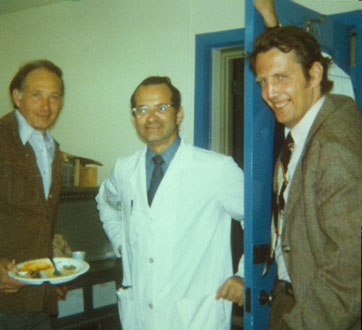John Karam

Professor of Medicine, University of California, San Francisco (7.20.1929 - 9.23.2002)
Part of the UCSF Metabolic Research Unit and Endocrine Division faculty from 1961 until 2002, John Karam was a clinical investigator, master clinician and educator. He is best remembered as translational scientist bringing clinical insights to his basic science colleagues and interpreting basic science to the clinicians.
Participating in two revolutionary waves of scientific discovery, the development of radio-immunoassays and molecular biologic techniques, John Karam and his colleagues were among the first to catalogue normal and pathophysiologic hormonal patterns and to define the genetic basis of diabetes. In collaboration with Gerald Grodsky, John Karam’s enduring research included the original observations that hyperinsulinemia is associated not only with type 2 diabetes but with obesity alone, even in the absence of diabetes (1-4). Current Contents recognized these observations as a Citation Classics . He also was one of the first to demonstrate that biguanide therapy reduces insulin resistance and can lower circulating insulin levels (5). In association with Jack Gerich and other members of the Metabolic Research Unit, Karam helped to define hormonal interaction and metabolic effects, especially the role of glucagon in normal as well as diabetic states(6-12) . Drawing on his work with Graeme Bell, Karam was the first to identify that a polymorphism on Chromosome 11 is a major susceptibility gene for type 1 diabetes. (13-15).
John Karam’s CV included over 150 significant publications and including 29 chapters on Diabetes Mellitus for “Current Medical Diagnosis and Treatment”, “Basic and Clinical Endocrinology”, “Basic and Clinical Pharmacology”, and “Currently Emergency, Diagnosis and Treatment “for the Lange Medical Series. From 1980 until his retirement in 1993, Karam was the Chief of Clinical Endocrinology. Over the decades at UCSF he trained scores of housestaff and Endocrine fellows including dozens of “Dorothy Frank Diabetes Fellows.” He was received the American Diabetes Association “Outstanding Educator Award” in 1993.
Selected bibliography
- Karam, J.H., Grodsky, G.M., and Forsham, P.H.: Excessive insulin response to glucose in obese subjects and measured by immunochemical assay. Diabetes 12:197, 1963
- Karam, J.H., Grodsky, G.M., Pavlatos, F. Ch., and Forsham, P.H.: Critical factors in excessive serum insulin response to glucose: Obesity in maturity-onset diabetes and growth hormone in acromegaly.Lancet 1:286, 1965.
- Grodsky, G.M., Karam, J.H., Pavlatos, F. Ch., and Forsham, P.H.: Serum insulin response to glucose in prediabetic subjects. Lancet 1:290, 1965.
- Karam, J.H., Grodsky, G.M., and Forsham, P.H.: The relationship of obesity and growth hormone to serum insulin levels. Ann. N.Y. Acad. Sci. 131:374-87, (October) 1965
- Grodsky, G.M., Karam, J.H., Pavlatos, F. Ch., and Forsham, P.H.: Reduction by Phenformin of excessive insulin levels after glucose landing in obese and diabetic subjects. Metabolism 12:278, 1963.
- Simpson, R.G., Benedetti, A., Grodsky, G.M., Karam, J.H., and Forsham, P.H.: Stimulation of insulin release by glucagon in noninsulin-dependent diabetics. Metabolism 15:1046-9, 1966.
- Karam, J.H.: Radioimmunoassays of insulin and glucagon and their physiologic and clinical applications. In Laboratory Tests in the Diagnosis and Investigation of Endocrine Functions. (Escamilla, R.F., ed.) Philadelphia: F.A. David Co., 1971, pp. 175-186.
- Gerich, J.E., Karam, J.H., and Forsham, P.H.: Stimulation of glucagon secretion by epinephrine in man. J. Clin. Endocrinol. Metab. 37:479-481, 1973.
- Johnson, S.; Karam, J.H., Levin, S.R., Grodsky, G.M., and Forsham, P.H.; Hyperinsulin response to oral leucine in obesity and acromegaly. J. Clin. Endocrinol. Metab. 37:431-435, 1973.
- Gerich, J.E., Langlois, M., Noacco. C., Karam, J.H., and Forsham, P.H.: Lack of glucagon response to hypoglycemia in diabetes: Evidence for an intrinsic pancreatic alpha cell defect. Science 182:171-173, 1973.
- (11) Gerich, J.E., Schneider, V., Dippe, S.E., Langlois, M., Noacco, C., Karam, J.H., and Forsham, P.H.: Characterization of the glucagon response to hypoglycemia in men. J. Clin, Endocrinol. Metab. 38:77-82, 1974.
- Karam, J.H., Grasso, S.G., Wegienka, L.C., Grodsky, G.M., and Forsham, P.H.: Effect of selected hexoses, of epinephrine and of glucagon on insulin secretion in man. Diabetes 15:571-8, 1966
- Bell, G.I., Karam, J.H., and Rutter, W.J.: Properties of a polymorphic DNA segment in the 5’- flanking region of the human insulin gene. Prog Clin Biol Res 103 (Part A): 57-65, 1982
- Bell, G.I., and Karam, J.H.: The polymorphic locus flanking the human insulin gene: Is there an association with diabetes mellitus? In Recombinant DNA Applications to Human Disease (Banbury Report 14) Cold Spring Harbor, New York, 1983, pp. 317-326
- Bell, G.I., Horita, S., and Karam, J.H.: A Polymorphic Locus Near the Human Insulin Gene is Associated with Insulin-Dependent Diabetes Mellitus. Diabetes 33: 176-83, 1984
